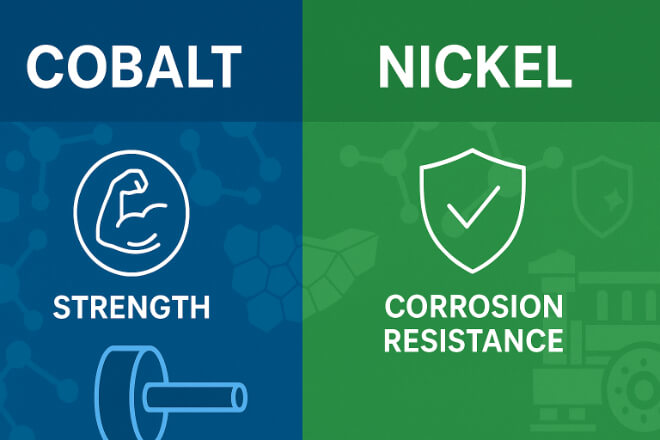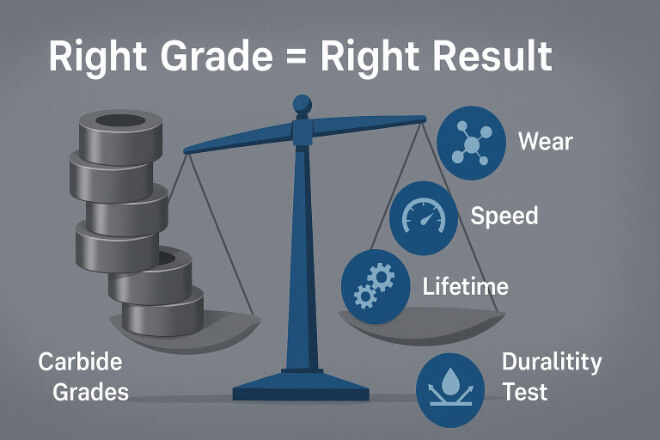Tungsten carbide bushings are used in pumps, compressors, turbines, and many types of rotating machinery.
Their job is simple — to reduce friction and wear between moving parts. But not all tungsten carbide bushings are the same.
Different grades of tungsten carbide are designed for different working conditions. Choosing the right grade can affect your equipment’s life span, performance, and cost-efficiency.
In this guide, we’ll explain the main grades of tungsten carbide bushings, compare their properties, and help you understand which one is best for your specific process.
What Does “Grade” Mean in Tungsten Carbide?

The grade of tungsten carbide refers to the specific combination of grain size, binder content, and binder type used in its formulation.
Each of these factors changes the balance between hardness, toughness, and wear resistance.
Grain Size: Fine grains increase độ cứng but reduce độ dẻo dai.
Binder Type: Cobalt or nickel binders hold tungsten carbide particles together.
Binder Content: More binder makes the material tougher, but slightly softer.
Manufacturers create different grades to match specific industrial needs — from abrasive slurry to corrosive chemicals or high-speed shafts.
Common Tungsten Carbide Grades for Bushings
Below are the most common grades used in industrial bushings, along with their key characteristics.
| Cấp | Loại chất kết dính | Binder (%) | Độ cứng (HRA) | Typical Application |
|---|---|---|---|---|
| YG6 | Cobalt | 6% | 91 | High wear resistance, low impact — seals, dies |
| YG8 | Cobalt | 8% | 89 | General purpose — good wear and toughness balance |
| YG11 | Cobalt | 11% | 87 | High-impact resistance — oil and gas pumps |
| YN6 | Nickel | 6% | 90 | Corrosion-resistant — chemical and seawater systems |
| YN9 | Nickel | 9% | 88 | Enhanced chemical and thermal stability |
Understanding Grain Size and Its Effects
The grain size of tungsten carbide crystals has a strong effect on performance.
Fine-grain carbides (below 1 µm) are harder but less tough. Coarse-grain carbides (2–4 µm) are tougher but slightly softer.
| Grain Type | Độ cứng | Độ dẻo dai | Sử dụng điển hình |
|---|---|---|---|
| Fine-grain (0.5–1 µm) | Rất cao | Vừa phải | Precision bushings, small pumps |
| Medium-grain (1–2 µm) | Balanced | Tốt | General industrial applications |
| Coarse-grain (2–4 µm) | Slightly Lower | Cao | High-impact pumps, drilling tools |
In short, fine-grain grades are best for wear, while coarse-grain grades are best for impact resistance.
Cobalt vs Nickel Binder: What’s the Difference?

Cobalt and nickel are the two main binders in tungsten carbide bushings.
Cobalt-bonded grades (YG series) have high strength and độ dẻo dai. They’re ideal for mechanical shock or dry-running applications.
Nickel-bonded grades (YN series) provide superior khả năng chống ăn mòn and are widely used in chemical, seawater, or food machinery.
Nickel-bonded carbide also resists oxidation better at high temperatures.
| Tài sản | Cobalt-Bonded Carbide | Cacbua liên kết niken |
|---|---|---|
| Độ dẻo dai | Cao | Vừa phải |
| Khả năng chống ăn mòn | Trung bình | Xuất sắc |
| Độ ổn định nhiệt | Tốt | Very Good |
| Ideal Application | Oil, gas, power equipment | Chemical, marine, and food machinery |
Matching Grades to Real Applications
Choosing the right tungsten carbide grade depends on working media, load, and temperature.
| Operating Condition | Recommended Grade | Key Advantage |
|---|---|---|
| High Wear, Low Impact | YG6 | Superior hardness and wear resistance |
| Balanced Wear & Impact | YG8 | All-purpose for general industrial use |
| High Vibration or Shock | YG11 | Excellent toughness for impact load |
| Corrosive Media (Seawater, Acids) | YN6 or YN9 | Resists chemical attack and oxidation |
By aligning grade choice with your operating conditions, you can maximize bushing performance and reduce replacement frequency.
Final Verdict

No single tungsten carbide grade fits every situation.
YG6 and YG8 are economical choices for general khả năng chống mài mòn.
YG11 works best in high-impact or vibration environments.
YN6 and YN9 are ideal for corrosive or marine systems.
For most industrial users, working with a supplier who can recommend custom grades based on real operating data is the best long-term strategy.
Phần kết luận
Understanding tungsten carbide grades helps decision-makers avoid premature wear, unnecessary maintenance, and equipment downtime.
The right grade can make a significant difference in both performance and operating cost.
By considering grain size, binder type, and application environment, engineers can ensure each bushing performs to its full potential.
For pumps, compressors, and machinery that run continuously, choosing the correct tungsten carbide grade means higher uptime, longer lifespan, and stronger ROI.
Nếu bạn muốn biết thêm chi tiết về bất kỳ công ty nào, vui lòng liên hệ với chúng tôi.
